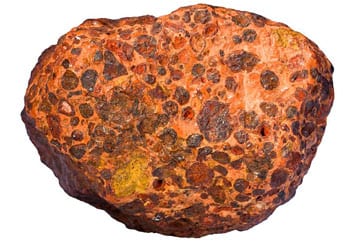Elekti lingvon:
Aluminio estas la plej ofta metalo elemento trovita sur la Tero, totaling about 8% de la tera krusto. Tamen, aluminum as an element is reactive and therefore does not occur naturally – it needs to be refined to produce aluminum metal. La primara starta materialo por aluminio agordo estas baŭksito, la monda ĉefa komerca fonto de aluminio. Bauxite is a sedimentary rock, and consists mostly of the aluminium minerals gibbsite (Al(OH)3), boehmite (c-Alo(OH)) kaj diaspore (a-Alo(OH)), and is usually mixed with the two iron oxides goethite and hematite, the aluminium clay mineral kaolinite and small amounts of anatase (TiO2) and/or ilmenite (FeTiO3).

Bauxite deponejoj estas disvastiĝis tutmonde, plejparte okazas en tropikaj aŭ subtropikaj regionoj. Although proven reserves of bauxite are expected to last for many years, la kvalito de la rezervoj kiuj povas esti ekonomie Montrita malpliiĝas. por rafinerioj, who are in the business of bauxite processing to make alumina, kaj finfine aluminio metalo, tio estas defio kun ambaŭ financaj kaj ekologiaj implicoj.
The process to refine metallurgical bauxite into alumina involves the following inputs:
The following outputs are generated:

The most widely used chemical process of refining bauxite into alumina, la Bayer-procezo, involves dissolving the Al2O3 out of the bauxite rock with caustic soda (NaOH) at elevated temperature and pressure. The Al2O3 fraction of the bauxite is dissolved into solution, to later be precipitated out as alumina. Tamen, a high-grade bauxite contains up to 60% Al2O3, and many operating bauxite deposits are well below this, foje tiel malaltaj kiel 30-40% Al2O3. Because the desired product is a high purity Al2O3, la ceteraj oksidoj en la baŭksito (Fido2Aŭ3, SiO2, TiO2, Organic material) are separated from the Al2O3 and rejected as alumina refinery resides (ARR) or red mud. Ĝenerale, la pli malalta kvalito la bauxita (ie lower Al2O3 content) the more red mud is generated per ton of alumina product. Krome, even some Al2O3 bearing minerals, precipe kaolinite, produce un-desirable side reactions during the refining process and lead to an increase in red mud generation, kaj ankaŭ perdon de multekostaj acida sodo kemia, granda variablo kosto en la bauxita rafinado.
Ruĝa koto aŭ ARR reprezentas grandan kaj daŭranta defio por la aluminio industrio. Ruĝa koto enhavas signifan postrestanta acida kemia postlasaĵo de la rafinado, kaj estas tre alkala, ofte kun pH de 10 - 13. It is generated in large volumes worldwide – according to the USGS, taksis tutmonda alúmina produktado estis 121 milionojn da tunoj en 2016. This likely resulted in more than 150 milionojn da tunoj da ruĝa koto generita dum la sama periodo. Malgraŭ daŭra esploro, ruĝa koto nuntempe havas malmultajn komerce farebla vojoj al utilaj re-uzo. Oni taksas, ke tre malmulte da ruĝa koto estas utile re-uzita tutmonde. Instead the red mud is pumped from the alumina refinery into storage impoundments or landfills, kie ĝi estas stokita kaj monitoritaj ĝenerale kosto.
La perdo de multekostaj acida sodo (NaOH) and the generation of red mud are both related to the quality of the bauxite used in the refining process. Ĝenerale, the lower the Al2O3 content of the bauxite, la pli granda la volumo de ruĝa koto kiu generos, as the non-Al2O3 phases are rejected as red mud. Krome, the higher the kaolinite or reactive silica content of the bauxite, des pli ruĝa koto generos. The reactive silica content not only increases the volume of red mud, but also consumes caustic soda reagent and reduces the yield of Al2O3 recovered from the bauxite. sekve, there is both an economic and environmental argument to be made for improving the quality of bauxite prior to refining.
La STET seka apartiga procezo proponoj Bauxite produktistoj aŭ bauxita rafinerioj ŝancon plenumi antaŭ-Bayer-procezo modernigo de bauxita erco por plibonigi la kvaliton. Tiu aliro havas multajn avantaĝojn:
En resumo, seka prilaborado kun la STET separador proponoj ŝancoj por generi valoro por baŭksito produktantoj kaj rafinerioj. La antaŭ-prilaborado de bauxita antaŭ rafinado reduktos kemiaj kostoj, malaltigi la volumo de ruĝa koto generita kaj minimumigi procezo maltrankviliĝoj.
Referencoj: